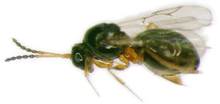Leptopilina
Leptopilina is a genus of parasitoid wasp in the family Figitidae. The genus is best known for the three Drosophila parasitoids Leptopilina boulardi, Leptopilina heterotoma and Leptopilina clavipes, used to study host-parasite immune interactions. The venom released by L. heterotoma during oviposition contains virus-like particles that delay host larval development and suppress the host cellular immune response.[2][3] There is no evidence that these virus-like particles are the products of viral DNA as described in other parasitoid taxa, .[4]
| Leptopilina | |
|---|---|
 | |
| Leptopilina boulardii (Eucoilinae), a parasitoid of Drosophila | |
| Scientific classification | |
| Kingdom: | |
| Phylum: | |
| Class: | |
| Order: | |
| Family: | |
| Subfamily: | Eucoilinae |
| Genus: | Leptopilina Förster, 1862[1] |
References
- Förster, A. 1862: Synopsis der Familien und Gattungen der Braconen. Verhandlungen des Naturhistorischen Vereines preussischen Rheinlande und Westphalens 19: 225–288.
- Rizki, R. M.; Rizki, T. M. (1990). "Parasitoid virus-like particles destroy Drosophila cellular immunity". Proceedings of the National Academy of Sciences. 87 (21): 8388–8392. Bibcode:1990PNAS...87.8388R. doi:10.1073/pnas.87.21.8388. PMC 54961. PMID 2122461.
- Heavner, ME; Gueguen, G; Rajwani, R; Pagan, PE; Small, C; Govind, S (2013). "Partial venom gland transcriptome of a Drosophila parasitoid wasp, Leptopilina heterotoma, reveals novel and shared bioactive profiles with stinging Hymenoptera". Gene. 526 (21): 195–204. doi:10.1016/j.gene.2013.04.080. PMC 3905606. PMID 23688557.
- Herniou, Elisabeth A.; Huguet, Elisabeth; Thézé, Julien; Bézier, Annie; Periquet, Georges; Drezen, Jean-Michel (2013). "When parasitic wasps hijacked viruses: genomic and functional evolution of polydnaviruses". Phil. Trans. R. Soc. B. 368 (1626): 20130051. doi:10.1098/rstb.2013.0051. PMC 3758193. PMID 23938758.
This article is issued from Wikipedia. The text is licensed under Creative Commons - Attribution - Sharealike. Additional terms may apply for the media files.